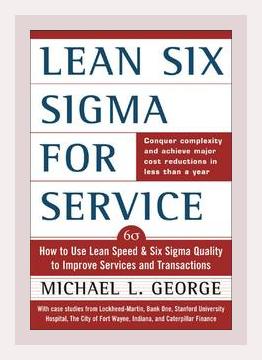Operations and Supply Chain ManagementProcess ImprovementQuality ControlLean Manufacturing
Summary: Lean Six Sigma for Service by Michael George
Introduction
“Lean Six Sigma for Service: How to Use Lean Speed and Six Sigma Quality to Improve Services and Transactions” by Michael George, published in 2003, is a comprehensive guide that merges principles from Lean Manufacturing and Six Sigma to enhance service operations. The book demystifies the application of Lean and Six Sigma in service industries, traditionally more associated with manufacturing, and offers practical strategies for improving speed, quality, and efficiency in service transactions.
Chapter 1: The Need for Lean Six Sigma in Service
The book kicks off by identifying the unique challenges within the service industry, such as variability in customer demand and human-centric processes, which can hinder efficiency and quality. George argues that despite these differences, Lean Six Sigma can be effectively applied to service sectors to streamline processes and reduce waste.
Action: Evaluate and document current inefficiencies and waste in your service operations to identify areas for improvement.
Chapter 2: Lean and Six Sigma Fundamentals
Lean focuses on increasing speed by eliminating waste, while Six Sigma emphasizes reducing errors and variation. The integration of both methodologies can significantly benefit service operations by optimizing processes and improving quality.
Example: A bank using Lean Six Sigma might streamline the loan approval process by minimizing unnecessary steps and ensuring accurate data collection at initial contact points.
Action: Train staff on Lean and Six Sigma principles to create a foundation for process improvement.
Chapter 3: Identifying Critical-to-Quality (CTQ) Elements
George emphasizes the importance of identifying CTQ elements that are crucial to customer satisfaction. In services, this often involves understanding customer expectations around speed, accuracy, and reliability.
Example: A call center might identify CTQs such as average call handling time, first-call resolution rate, and customer satisfaction scores.
Action: Conduct surveys or focus groups to determine what attributes are most valued by your customers.
Chapter 4: Mapping Service Processes and Identifying Wastes
Process mapping is a key tool for identifying wastes in a service environment. The book explains how to create process maps and use techniques like Value Stream Mapping (VSM) to visualize existing processes and pinpoint areas of waste.
Example: A healthcare provider might map out the patient admission process, identifying delays and redundancies such as repeated data entry.
Action: Create detailed process maps of your service workflows and conduct a waste analysis to identify non-value-added activities.
Chapter 5: Lean Tools for Service Improvement
George adapts several Lean tools for use in services, including 5S (Sort, Set in Order, Shine, Standardize, Sustain), Kaizen (continuous improvement), and Just-In-Time (JIT).
Example: Implementing a 5S strategy in a pharmacy can help organize drugs and supplies to reduce time spent searching for items.
Action: Choose one Lean tool to implement in your service operation and develop a step-by-step plan for its adoption.
Chapter 6: Six Sigma Tools for Service Quality
Six Sigma tools such as DMAIC (Define, Measure, Analyze, Improve, Control) and statistical process control are also adapted for service environments. These tools help to systematically identify and eliminate defects.
Example: A hotel chain might use DMAIC to reduce the number of booking errors by analyzing root causes and implementing policy changes.
Action: Launch a Six Sigma project using the DMAIC framework on a process with high variability or defect rates.
Chapter 7: Integrating Lean and Six Sigma
The combined approach of Lean Six Sigma offers a powerful framework for transforming service operations. George outlines how to synchronize Lean’s speed focus with Six Sigma’s quality focus for maximal impact.
Example: A logistics company might combine Lean tools to speed up delivery routes and Six Sigma techniques to ensure package accuracy.
Action: Form a cross-functional team to pilot an integrated Lean Six Sigma project in a specific service area.
Chapter 8: Case Studies
The book provides numerous case studies that illustrate successful Lean Six Sigma applications in service industries. These real-world examples show how different organizations have achieved substantial improvements.
Example: A financial services company reduced its mortgage processing time by 50% while improving accuracy by using a combination of process mapping, waste elimination, and defect reduction strategies.
Action: Review case studies relevant to your industry to gain insights and inspiration for your Lean Six Sigma initiatives.
Chapter 9: Measuring Improvement
George stresses the importance of establishing metrics to quantify improvements. Performance measures should align with CTQs and provide clear insights into the impact of Lean Six Sigma initiatives.
Example: A retail business tracks metrics such as order fulfillment time, customer wait times, and error rates before and after Lean Six Sigma implementation.
Action: Develop a set of KPIs (Key Performance Indicators) that align with your CTQ elements and regularly monitor these metrics to track progress.
Chapter 10: Sustaining Improvement
Sustained success requires continuous monitoring, employee engagement, and a culture of continuous improvement. George discusses techniques for sustaining improvements over the long term.
Example: A utilities company fosters a culture of continuous improvement by regularly holding Kaizen events and recognizing employees who suggest impactful improvements.
Action: Establish a continuous improvement program that includes regular training, ongoing assessment, and a reward system for employee contributions.
Conclusion
Michael George’s “Lean Six Sigma for Service” offers a valuable framework for service organizations looking to enhance efficiency and quality. By adopting Lean’s focus on speed and Six Sigma’s emphasis on error reduction, service industries can achieve remarkable improvements that drive customer satisfaction and operational excellence.
Final Action: Start small with a pilot project, use the learnings to refine your approach, and scale up your Lean Six Sigma efforts across the organization for comprehensive improvements.
Operations and Supply Chain ManagementProcess ImprovementQuality ControlLean Manufacturing
